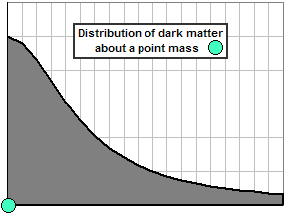| Theory of Everything |
There's this so-called Theory of Everything which hopes to explain the universe and all its interactions and forces and ...
>Don't tell me! You have such a theory. Am I right?
No, you're not right.
However, I was reading this blog and the authors begin with the claim that:
The amount of energy is proportional to its volume.
That got me thinking.
>That was your first mistake.
Suppose that, as Findlay & Haenggi suggest, Energy is proportional to Volume.
That is, an Energy E would be associated with a Volume V, and:
[1] E = k V for some constant k.
Since Energy has the dimensions of M (L2 / T2)
where E = Mass, L = Length and T = Time
and Volume has the dimensions of L3, then:
[2] E / V = k = M (L2 / T2) / L3
However, speed2 has the dimensions of (L2 / T2) and mass density has the dimensions of M /L3, so we can write:
[3] E / V = ρ c2
where ρ is some mass-density and c is some speed.
Now we have the constant k, eh?
>Some density? What density? What speed?
I thought you'd never ask. 
We should pick something that's sexy, like
[4] ρ = density of the mass within the Volume and c is the speed of light.
>You're kidding, right? The speed of light is HUGE! Every bit of volume has that much energy? Remember E = m c2?
Well, let's see. The density of the universe is roughly 10-30 gm/cm3
and the speed of light is about 3x1010 cm/sec so we'd get something like:
[5] E / V = 9x10-10 gm/cm/sec2 or ergs.
>Is that a lot?
Okay, 1 calorie is about 4.2x107 ergs so ...
>So an erg is about ... uh, let's see ...
The energy associated with a cubic centimetre is roughly 2 x 10-17 calories ... and that's pretty small.
Notice that we don't distinguish between Volume and Energy.
>So all volume has energy?
Well, all volume that contains some mass, as measured by ρ.
Indeed, we might posit the existence of "invisible" matter in every volume, so every volume is associated with some energy.
>Huh? Invisible?
Yes. Matter that can't be observed directly, but only assumed. Let's call this ...
>How about dark matter?
Excellent! 
- Consider a mass m1 residing within some Volume V1.
- We assume it absorbs energy from the surrounding volume, so that surrounding volume might diminish.
Could be.
- Consider a second volume within which lies a second mass m2 within Volume V2.
- Each absorbs energy from the surrounding volume ... hence from each other.
- Maybe the volume of space between the two masses diminishes.
Could be. And that's called ...
>Gravitational attraction?
Excellent! 
>But if the Energy is constantly being absorbed by m1, then doesn't V1 continually increase?
Ah, yes ... because Energy is equivalent to Volume, eh? One one goes up, so must the other.
But let's look again at [3]. If E increases, it could be because ρ increases, not V.
>If ρ increases then the mass m1 increases. Is that what happens? The mass gets continually heavier?
The density of matter within V1 could increase without m1 increasing. It could be that "other" matter enters V1.
>Don't tell me! Dark matter?
Why not? Isn't it fun to speculate?
>No! Maybe you've heard of Newton. He said that gravitational acceleration is inversely proportional to the square of the distance separating two masses.
Aha! And you want to know how we'd get that, eh?
Okay, let's consider the distance between the two masses. We'll call it R.
- Mass m2 lies on the surface of a sphere or radius R with mass m1 as centre.
- The Energy being absorbed by m1 passes through the surface of this sphere with surface area 4πR2 (on its way to m1).
- The density of Energy being absorbed, at the location of this surface, is E / 4πR2 energy-units per unit area.
- It's this Energy-density which generates the gravitational acceleration ... so the acceleration is inversely proportional to R2.
>Do you really believe this stuff?
Is that relevant? It's fun! And it makes you think. 
|
>Okay, so material masses attract Energy in the form of dark matter. That'd mean that dark matter congregates about material masses, right?
Why not? We might imagine every mass having a cloud of dark matter about it. Indeed, we might imagine a distribution of dark matter about the mass ... with an energy-density which decreases as we move away from the mass. >An inverse square law distribution!
|  |
| Space-Time stuff |
Note that we may write introduce a 4-dimensional space-time universe, with dimensions identified by
[6a] x, y, z and τ = ct
... where c is the speed of light so τ = ct has the dimensions of length.
An elemental volume in space-time would be measured by
[6b] dv = dx dy dz dτ = c dx dy dz dt
In order to incorporate space-time, we could change [3] for an elemental space-time volume dv and associated energy dE ... like so:
[7a] dE / dv = ρ c2
... where ρ measures the mass density within the volume dv.
Or, to put it differently:
[7b] dE = ρ dv c2 = ρ dxdydz c3 dt = m c3 dt ... where m is the mass within the volume dv.
>Haven't you heard of Einstein? He says: E = m c2?
Einstein? Never heard of him.
If you'd like to discuss the ramifications of the theory, please write to the authors at: the blog
